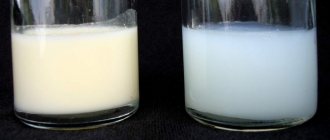Colostrum
Colostrum may appear in the third trimester of pregnancy and only within 3-4 days after birth. Replaces its transitional milk. Those who are wondering how to distinguish colostrum from breast milk should keep in mind that the former is yellowish, sticky and looks like a kind of mush that comes out of the breast in a small volume.
Don't be upset that your child isn't getting enough to eat. This amount of food is quite enough for him. Colostrum is small, but it is extremely nutritious. It contains a lot of protein, minerals, enzymes, antibodies, which have an anti-inflammatory effect. The difference between colostrum and breast milk is that the former acts as the mildest laxative, helping the baby to have its first stool. This is essentially a vaccine for the baby. Colostrum covers the walls of the gastrointestinal tract, preventing harmful bacteria from multiplying. It has many more benefits that are currently under research. So the differences between colostrum and milk will only be established in the future.
©2019 Yakovlev Ya.Ya.
A woman's colostrum can be yellow to yellow-orange in color. The normal color of mature human milk at various stages of lactation ranges from bluish-white to creamy or yellow-white. The color of foremilk and hindmilk is also different, which is due to some difference in their composition.
However, the greatest concern for nursing mothers can be the coloring of milk in other colors. More often, these changes are associated with the consumption of any colored foods, herbal seasonings, teas or medications. The number of publications on this topic turned out to be quite limited, but I tried to collect available sources.
Pink or pink-orange milk.
Carbonated drinks containing red and pink dyes can give breast milk a pink or pink-orange color. The same color of milk can be obtained when using fruit drinks, gelatin desserts and fresh beets in the diet. In some children, during the period of consumption of such milk, the urine may turn a corresponding color. In the absence of obvious food causes of coloring, it is necessary to remember the possible colonization of breast milk by the gram-negative bacteria Serratia marcescens, which synthesizes the red-orange or bright red pigment prodigiosin. Not only the breast milk itself can become stained, but also the breast pump that a woman uses to express herself.
Pink coloration of a fabric towel when infested with Serratia marcescens. From Valle S.A., Salinas E.T., 2014
Pink coloration of a fabric towel when infested with Serratia marcescens. From Valle S.A., Salinas E.T., 2014
Expressed breast milk after and before antibiotic therapy. From Valle S.A., Salinas E.T., 2014
Pink breast milk in a bottle. From Clifford V. et al., 2014
Growth of the bacteria Serratia marcescens. From Clifford V. et al., 2014
Painting a breast pump pink. Faro J., 2011.
Serratia marcescens is an opportunistic nosocomial microorganism. Its growth is observed in hospital equipment, including breast pumps and ventilators. Bacterial growth is also possible if breast pumps, nipples, and breast shields are not properly treated at home. Published cases indicate that the pink milk symptom appeared in breastfeeding women between 5 and 12 weeks postpartum. Some suffered from lactation mastitis before the milk became colored, which was treated with antibiotics. Some women did not suffer from any inflammatory diseases and did not use breast pumps. During the period of staining, mothers and their children did not have any signs of an infectious process. Some women continued to breastfeed, while others stopped on their own. Subsequently, in consultation with medical professionals, women were encouraged to continue breastfeeding. In the described cases, in the presence of positive Serratia marcescens culture from breast milk, some women were treated with antibiotics. Others did not receive any drugs because at the time of receiving the seed there were no manifestations in either the mother or her child. It follows from this that at the moment there is no clear opinion about the need to treat this microorganism in a healthy mother-child pair. All authors agree that if there is a symptom of “pink milk” and proven seeding of Serratia marcescens, it is necessary to thoroughly treat all items used when feeding the child (pacifiers, breast pumps, breast pads, etc.), and it is better to completely replace them with new ones. In a randomized controlled trial, it was shown that the incidence of contamination of expressed milk with various bacteria (not only Serratia marcescens, but also others) can reach 61-86%. At the same time, in a hospital (maternity hospital) during pumping, the frequency of contamination of breast milk was equally high both when using breast pumps and when manually expressing. At home, the incidence of milk contamination was statistically significantly higher when expressing with a breast pump than when expressing by hand. Accordingly, the very fact of using all kinds of “devices” (breast pumps, breastplates, supplementary feeding systems, pacifiers, etc.) in an exclusively breastfed child carries a risk of infection of breast milk.
Green milk.
According to observations, this color was given by Gatorade drink, kelp, spinach, various seaweed (especially in tablet form) and some natural vitamins. At the same time, the child’s urine was also colored. The literature describes cases of the appearance of green coloration in breast milk after the administration of propofol, which is used for surgical intervention.
Blue milk.
Blue coloring of breast milk can be caused by food colorings and herbal supplements. If such milk is left for storage, it will gradually turn white.
Black milk.
A woman's use of minoccycline hydrochloride for acne may cause black color in breast milk. During the study, it turned out that some of the cells (macrophages) contained hemosiderin, which gave the milk a black color. This drug may cause the skin to turn black.
Rusty-pipe syndrome.
The appearance of brown or bloody coloration in breast milk. The main causes of blood in breast milk are mastitis, cracked nipples, trauma, ductal papillomas, fibrocystic disease and cancer. The first three occur with pain in the mammary gland and can occur in a nursing mother during any period of lactation. The last three conditions do not always cause pain, but the duration of milk coloration with them is much longer. The intensity of milk coloring depends on the amount of blood. If there is significant damage (cracks) in the milk, drops or streaks of blood are visible. A small loss of blood gives a brown (rusty) color to the milk, which gives rise to the name “rusty pipe syndrome.” Such staining often appears in the early period after childbirth and may go unnoticed, since it does not cause any inconvenience to the nursing woman. Most often appears on both sides. Rusty pipe syndrome occurs due to a large number of blood capillaries in the rapidly developing alveoli. These capillaries are easily damaged and cause bleeding from the nipples. The process is self-limiting and does not require cessation of breastfeeding. Stops within a few days. Any manipulation of the nipple should be avoided. If the baby tolerates milk well, breastfeeding can continue. Similar manifestations can occur in a pregnant woman in late pregnancy. Their reason is the same - significant development of the capillaries of the alveoli in the mammary gland. If the secretion of brown milk persists for more than a week, a mandatory examination by a doctor, ultrasound of the mammary glands and cytology are necessary to exclude ductal papillomas and fibrocystic disease.
Discharge of blood from the nipple. Thota U. et al., 2012.
Bibliography.
Transition milk
The next type of breast milk is the transitional form. At this stage, the woman feels that her breasts are swollen and heavy. If she is wondering how to distinguish colostrum from transitional milk after childbirth, she should keep in mind that the latter will be more watery. It has a transparent color.
Milk of this form contains a large amount of antibodies and protein. It is then that mothers most often begin to fatten their children, thereby disrupting lactation. During this period, children are more likely to reach for the breast.
Mature
Mature milk stabilizes from 2-6 weeks after birth. And at this stage, the woman stops wondering how to distinguish milk from colostrum. This is a mature variety with a bluish tint. This liquid contains less protein. You often hear: if you leave breast milk in a container and no cream forms from it, then the liquid is not thick enough and the baby will not get enough. This is a false belief. It must be remembered that human milk is intended only for a small child. Throughout pregnancy, the female endocrine system adapted it quantitatively and qualitatively for the baby.
Lochia after childbirth: norm and pathology
How long does lochia last after childbirth
? In order to respond in a timely manner to possible deviations from the norm, every woman in labor should know the answers to the following questions: when does lochia end and how long normally does lochia last after childbirth. This will help identify the presence of pathology and promptly consult a doctor.
In what cases may a deviation from the norm be suspected?
- Scanty lochia after childbirth (especially during the first week) may indicate the presence of lochiometra, a pathological condition in which discharge accumulates in the uterine cavity. Stagnation of lochia after childbirth can be caused by difficulty in passing through the cervical canal due to blood clots or its spasm.
- In some cases, the color of lochia does not change over time from bright red to brown and yellow. This may be a symptom of a bleeding disorder.
- An unpleasant odor of lochia after childbirth, pain in the lower abdomen, fever, weakness, the presence of purulent impurities - all this may be a sign of endometritis or endomyometritis - inflammation of the uterus.
- Early cessation and resumption of profuse red lochia with blood clots a month after birth or earlier may indicate uterine bleeding due to remnants of the placenta or amniotic membranes.
- Prolonged bleeding (more than 1.5-2 months) may indicate insufficient contractility of the uterus. In such cases, injections of oxytocin (Oxytocinum), a hormone that promotes intense contractions of this organ, may be prescribed.
Expert opinion
If you have any doubts about the intensity, duration, smell or color of lochia, be sure to consult a professional. The doctor will conduct an examination and ultrasound of the pelvic organs, and will also answer your questions about what lochia should look like after childbirth.
Obstetrician-gynecologist of the highest category Oksana Anatolyevna Gartleb
Properties
Mother's milk is the baby's best source of nutrients necessary for development and growth. This liquid is best suited to the baby's needs. It affects hormonal balance and the immune system. The absorption of nutrients from mother's milk is much higher than when feeding a baby with formula. The composition of human milk is not constant and varies depending on the stage of lactation, feeding time, duration of feeding and the infant's suction strength. For this reason, women often wonder how to distinguish milk from colostrum.
Tangible benefits
After birth, the child needs maximum protection and gentle adaptation to new conditions.
Immunity
The first drops of milk, like a safe vaccine, provide the body with immunomodulatory and growth-stimulating properties - protect the child from infections and guarantee adequate development and growth.
Female colostrum is necessary to launch the overall immunity of the newborn.
It promotes the production of interferon, prevents the proliferation of a number of bacteria and viruses from the first hours of life, which come into massive contact with the baby. A valuable characteristic of colostrum is its IgA saturation. Through the placenta, the child received IgG from the mother, which strengthens the body's general resistance. Colostrum provides the supply of IgA, protecting the most vulnerable places - the mucous membranes of the throat and gastrointestinal tract.
Digestion
The effect of first milk on the baby’s digestive system is especially beneficial. Enveloping the walls of the stomach and intestines, it prevents foreign elements and organisms from multiplying. Prebiotics in colostrum allow you to populate the gastrointestinal tract with beneficial microflora. The laxative effect helps the baby more easily get rid of meconium and excess bilirubin, thereby preventing jaundice.
By waiting for milk to come in after childbirth, ignoring the baby's frequent breastfeeding and feeding him with artificial formula, you can deprive the baby of the most valuable first nutrition.
Appearance
Colostrum is a thick, yellowish liquid, sometimes transparent. This is the so-called first milk. Colostrum looks like cream and is rich in protein, vitamins and immune bodies. It destroys pathogenic microorganisms. Contains immunoglobulins against polio, influenza, salmonella bacteria and numerous viruses. During the first day after birth, its amount can reach 100 ml.
For those wondering how to distinguish milk from colostrum, it is worth keeping in mind that mature milk appears about a week after birth. It contains much more, and the caloric content of food is the most important characteristic at the end of feeding.
Chemical composition of colostrum
The calorie content of colostrum is significantly higher than breast milk, more than 2.5 times. 100 ml of secretion obtained after childbirth contains up to 150 kcal. Gradually, every day, calories decrease, and on the 3-5th day of lactation there are no more than 70-80 per 100 ml.
The chemical composition of colostrum is closer to that of blood than breast milk:
- complete finely divided protein and some casein;
- carbohydrates, predominantly oligosaccharides and polysaccharides;
- emulsified fats;
- essential amino acids, peptides, enzymes, hormones;
- immunomodulators, in particular albumins, globulins, lactoferrin, live leukocytes-macrophages;
- antioxidants – selenium, zinc, beta-carotene;
- vitamins – E, A, C, PP, K, D, group B;
- microelements - calcium, potassium, magnesium, sodium, iron, copper, zinc and others.
The total composition list exceeds 500 values. Analysis of colostrum also showed that it contains a minimal amount of water, which serves to prevent overload of the immature kidneys of the newborn.
Allergy to colostrum is excluded. The secret is a factor preventing the development of allergic reactions in a child in the future. Foreign components that get into it after using medications or nutritional supplements can, in very rare cases, trigger allergic symptoms.
Compound
The main component in breast milk is casein. It is completely and quite easily absorbed by the child’s body. Because casein is eliminated quickly, babies become hungry faster than bottle-fed babies. In the first days of lactation, human milk contains a lot of cystine and taurine, which are necessary for the development of the newborn's brain. The protein content in milk decreases throughout the entire feeding period, so around the sixth month of life, the baby should begin to be given complementary foods little by little.
The composition of this liquid ensures the absorption of fat-soluble vitamins. It helps maintain the structure of cell membranes and nerve cells in good condition, and promotes the development of vision in a newborn child. Breast milk is rich in polyunsaturated fatty acids, which are necessary for proper brain development, as well as increasing the baby's resistance to infections. The fat concentration is lowest at the beginning of feeding and increases towards the end of the baby's breastfeeding. Long breaks between feedings reduce the amount of fat in the milk.
Milk sugar and lactose provide the child with energy. Breast milk contains much more lactose than, for example, cow's milk. Lactic acid bacteria during breastfeeding provide the best protection against infections of the baby's gastrointestinal tract.
Formula contains many more compounds than breast milk, so bottle-fed babies tend to retain fluid. Microelements from the mother's food are optimally absorbed by the child. Breast milk contains little iron, and the lactoferrin involved in it binds the elements in an optimal way so that the baby can absorb them. In mixtures, lactoferrin is not observed, so excess iron in the body can contribute to the development of bacteria. Vitamin K should be given to the baby during the first three months of breastfeeding.
The immune forces of a child in the first year of life are still immature. Antibodies obtained after childbirth quickly degrade. Mother's milk is the best protection against infections for the baby. Colostrum contains a large amount of antibodies that protect the mucous membranes of the gastrointestinal, respiratory and urinary tracts. Therefore, those who are wondering how to distinguish milk from colostrum should not worry. Nature has provided virtually everything.
When does colostrum appear on a regular basis and why is it important for a child to receive it?
In appearance, colostrum is a translucent viscous liquid. Its main feature is the high content of easily digestible fine protein. Colostrum is secreted after childbirth in a more or less significant volume, which is enough to fill the small stomach of a newborn. Therefore, experts strongly recommend putting your baby to the breast as early as possible, ideally immediately after birth.
In addition to saturation, this unique product has a number of properties that baby needs, in particular:
- improves the body's protective functions due to the presence of immunoglobulin A and beta-carotene;
- relieves the urinary system, since there is practically no water in colostrum;
- helps the body remove bilirubin and thus prevents the development of jaundice;
- takes part in the formation of nervous and muscle tissue, as well as the retina of the eye - the vitamins A and E, selenium and zinc present in it are responsible for this.
In terms of its qualitative composition, colostrum from the mother’s breast is almost similar to the composition of the newborn’s blood serum, which means it is not perceived by the body as a foreign substance. This is especially important in the first days of life, when the baby’s gastrointestinal tract adapts to the outside world and circumstances.
The shade of the liquid can vary from yellowish to gray: the color of colostrum largely depends on the woman’s diet, so deviations in any direction cannot be considered a pathology.
The baby should be fed colostrum in the first 2-3 days after birth. Then, firstly, the mother begins to mature first transitional, and then mature breast milk, and secondly, the newborn, who has received nutritional preparation with the help of colostrum, becomes able to absorb mother's milk, which means it is time to move on to full feeding .










